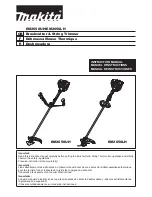
PREPARATION FOR USE
S A F E T Y
Before connecting the instrument to the power source,
carefully read the following information, then verify that
the power cord and power line fuse are ones for your power
line.
The instrument's rear panel has a fuse holder on the left of
the A C inlet terminal (the fuse holer also serves as a
voltage selector). The value under the triangle • marked
on the holder indicates the line voltage set for the instru-
ment. If the power cord is not applied with the correct
voltage, there is a danger from electric shock.
Line voltage
This instrument operates using ac-power input voltages
that 1 0 0 / 1 2 0 / 2 2 0 / 2 4 0 V at frequencies from 50 Hz to
60 Hz.
Power cord
The ground wire of the 3-wire ac power plug places the
chassis and housing of the oscilloscope at earth ground. Do
not attempt to defeat the ground wire connection or float
the oscilloscope; to do so may pose a great safety hazard.
The appropriate power cord is supplied by an option that is
specified when the instrument is ordered.
The optional power cords are shown as follows in Fig. 1 .
Line fuse
The fuse holder is located on the rear panel and contains
the line fuse. Verify that the proper fuse is installed by
replacing the line fuse.
5. Always use the probe ground clips for best results. Do
not use an external ground wire in lieu of the probe
ground clips, as undesired signals may be introduced.
6. Operation adjacent to equipment which produces strong
ac magnetic fields should be avoided where possible.
This includes such devices as large power supplies,
transformers, electric motors, etc., that are often found
in an industrial environment. Strong magnetic shields
can exceed the practical C R T magnetic shielding limits
and result interference and distortion.
7. Probe compensation adjustment matches the probe to
the input of the scope. For best results, compensation
of probe should be adjusted initially, then the same pro-
be always used with the input of scope. Probe compen-
sation should be readjusted whenever a probe from a
different scope is used. (See page 19)
8. In X - Y operation, do not pull out the P U L L x 10 MAG
switch. If pulled out it, noise may appeare on the
waveform.
E Q U I P M E N T P R O T E C T I O N
1. Never allow a small spot of high brilliance to remain sta-
tionary on the screen for more than a few seconds. The
screen may become permanently burned. A spot will oc-
cur only when the scope is set up for X - Y operation and
no signal is applied. Either reduce the intensity so the
spot is barely visible, switch back to normal sweep
operation when no signal is applied, or set up the scope
for spot blanking.
2. Never cover the ventilating holes on the top of the
oscilloscope, as this will increase the operating
temperature inside the case.
3. Never apply more than the maximum rating to the
oscilloscope inputs.
C H 1 , C H 2 INPUT jacks: 500 Vp-p or 2 5 0 V (dc + ac
peak)
CH3 INPUT jack: 50 V (dc + ac peak)
Z axis INPUT jack: 50 V (dc + ac peak)
Never apply external voltage to the oscilloscope output
terminals.
4. Always connect a cable from the earth ground (GND)
jack of the oscilloscope to the chassis of the equipment
under test. Without this caution, the entire current for
the equipment under test may be drawn through the
probe clip leads under certain circumstances. Such con-
ditions could also pose a safety hazard, which the
ground cable will prevent.
7
Summary of Contents for CS-1045
Page 34: ...MEMO 3 4 ...








































